by Matt Lollar | Jan 25, 2018
We’re having a cold winter this year and I’m sure the last thing on your mind is your spring garden, but it’s time to start ordering seeds! The spring gardening seed catalogs are now out on garden center magazine racks and it’s tempting to buy everything that looks good in pictures. However, there are a few things to think about when picking out what you want to grow.
Know Your Season
Vegetable crops are usually grown by season. We are lucky in Florida because we have both a warm season and a cool season. We are unlucky too because we have very hot summers! Usually our spring crops suffer from too much heat and humidity in July and August. Cool season crops are typically planted from September to March, while warm season crops are typically planted in February and March or August and September. Eggplant and okra are outliers because they can usually make it through the summer. It’s important that you follow tried and true planting dates for the crops you intend to grow. You can find a very helpful table embedded in the Florida Vegetable Gardening Guide that lists what to plant when.
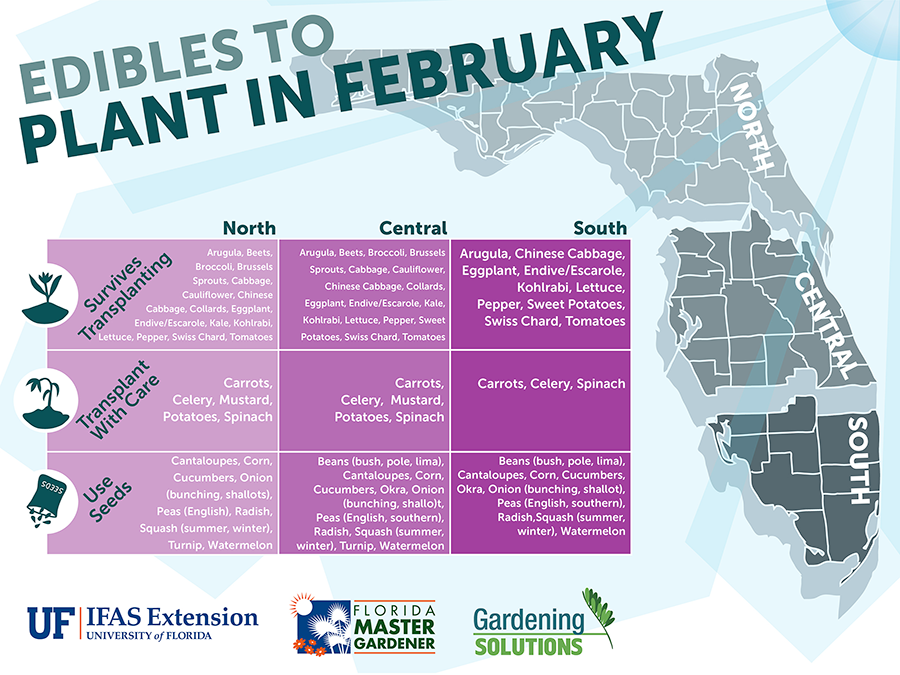
Know Your State
As you may have noticed, North Florida has a very humid climate year-round. We not only have to give our crops extra care due to rain and humidity, but we also need to grow varieties adapted for our climate. Some recommended varieties are listed in Table 2 of the Florida Vegetable Gardening Guide. You can also find some recommended varieties in Seed Sources for Florida Homegrown Vegetables. (Please note that some of the seed sources listed in this publication are geared more toward commercial growers, so they may be unavailable unless you intend to plant quite a few acres in one crop.)
Know How Green Your Thumb Is
Probably the most important thing about gardening is your level of commitment and experience. Take a few minutes to assess your skills as a gardener and the amount of time you are willing to commit to your garden. Then use the following list to help you determine what to plant.
- Easy to Grow in Florida – Radish, Collard, Turnip, Kale, English Pea, Green Bean, Sweet Potatoes
- Somewhat Easy to Grow in Florida – Okra, Yellow Squash, Zucchini, Eggplant, Watermelon, Sweet Corn
- Hard to Grow in Florida – Tomato, Cantaloupe, Muskmelon, Pumpkin
This is only a short list, but I hope it gives you a starting point to help you determine your skill set.
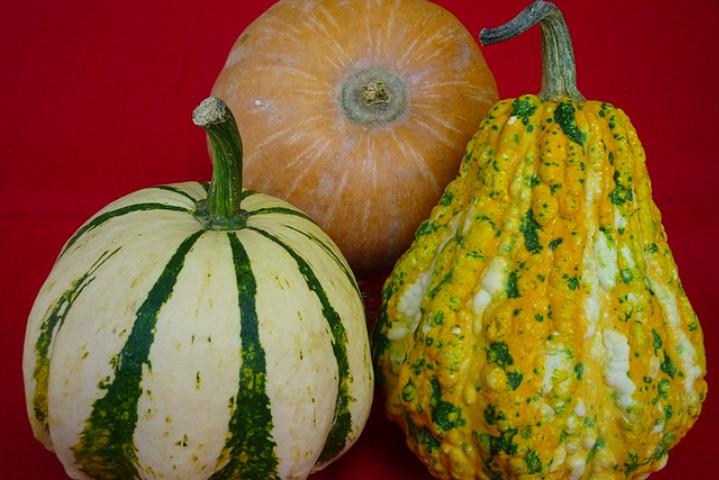
A variety of calabaza squash. Photo Credit: University of Florida/IFAS
Know the Difference Between Open Pollinated, Heirloom, and Hybrid Varieties
- Open-pollination of crops occurs when insects, birds, wind, or other natural mechanisms carry pollen from flower to flower. Seed can be saved from open-pollinated varieties which will produce crops with similar characteristics to their parents.
- Heirloom varieties have a history of being passed down within a family or community. As the name suggests, seed can be saved from heirloom varieties which will produce crops with similar characteristics to their parents.
- Hybridization is a controlled method of pollination in which the pollen of two different varieties or species is crossed by human or natural mechanisms. Seed saved from hybrids will most likely not produce as vigorously as their parents and may produce crops that are significantly different from their parents.
I would never want to discourage you from growing new crops, but I hope you now have a little better plan as to what to plant this year. If you want to try something new with minimal risk then I would recommend you try growing yard-long beans, calabaza squash, and malabar spinach. These vegetables serve as excellent substitutes for some of the more commonly grown varieties. You can read more about these crops and other minor vegetables by visiting the University of Florida/IFAS Minor Vegetable Webpage.
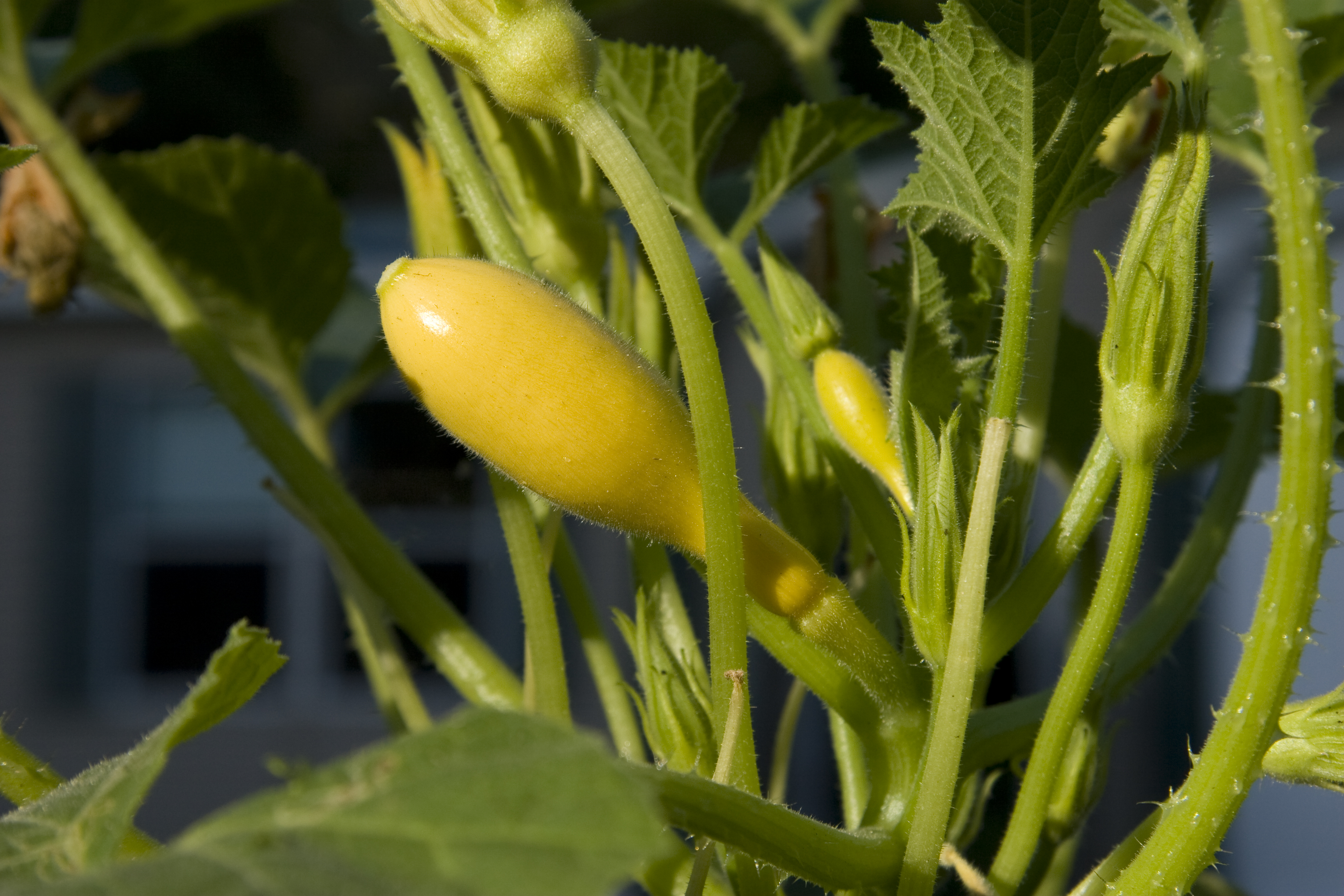
by Mary Salinas | Jan 25, 2018
Get a head start on your spring vegetable garden by planting seed now for some of your favorite spring crops. A great advantage to starting from seed is the seemingly endless number of varieties of your favorite vegetables that are available from online seed companies. You can experiment with new and heirloom varieties. Look to plant several different varieties that will mature at different times, thereby lengthening your harvest season.
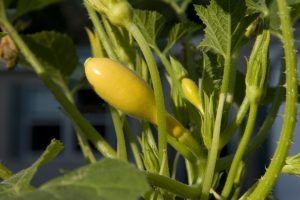
Home grown squash. UF/IFAS Photo by Tom Wright.
Seed is also cheaper than purchasing transplants, especially if you save your seeds in optimal conditions. To save leftover seed, keep it tightly closed in the original packet and store in a closed jar or plastic storage bag along with a desiccant (one of the little packs that come in vitamin bottles or shoe boxes) to absorb any excess moisture. Place in a consistently cool place, like your refrigerator. Some seeds naturally keep longer than others.
No fancy pots are needed, just about anything several inches wide and deep with a drainage hole will work. The pots should sit in a shallow waterproof tray to catch the runoff. Be sure to sterilize any reused pots with a solution of 1 part chlorine bleach to 9 parts water to destroy any lingering pathogens from the previous plants.
A commercial seed-starting mix is your best choice. Compressed peat or coir pots are also a good choice. Some all-purpose potting mixes are okay, but others are heavy and can hold too much water and promote fungal disease.
Plant the seed according the packet instructions, water well and place in a nice sunny spot where you can check them every day. If you don’t have a convenient sunny spot, a shop light with florescent and/or grow lights mounted about 6 inches above the tops of the plants will work well. A timer for the light is a handy device to make sure your seedlings have a good 14-16 hours of light a day. If your pots are in a sunny window, rotate them 180° daily to insure uniform growth. If you find your seedlings skinny and stretched, they are not getting enough sun.
Make sure that the soil stays evenly moist from the time of planting until the young plants are ready for your garden. A clear cover over the pots or tray will help to keep moisture consistent while the seeds germinate.
When the time comes to transition your plants to the outdoors, do it gradually. Expose them to the sun for an hour or two the first day and gradually increase their ‘sunbathing’ time each day for about a week and then transplant them to their new home.
Happy Gardening!
For more information:
Florida Vegetable Gardening Guide
Organic Vegetable Gardening in Florida
Seeding the Garden
Starting the Garden with Transplants
by Matt Lollar | Jan 25, 2018
The Jackson County Master Gardeners are hosting a hosting a Mushroom Growing Workshop on Saturday, February 10 at the Jackson County Extension Office, 2741 Penn Ave., Marianna, FL.

Shiitake mushrooms growing on a log. Photo Credit: University of Florida/IFAS
MUSHROOM GROWING WORKSHOP
SATURDAY, FEBRUARY 10
9:00 AM to 2:00 PM
• Learn to grow shiitake mushrooms on logs.
• Learn about mushroom nutrition.
• Take home an inoculated mushroom log!
• A home cooked lunch is included!
Registration Fee $20.00
Includes Lunch
Space is Limited
To register, contact the Extension Service at (850)482-9620 or s.farr@ufl.edu.
Pre-register by February 7th.
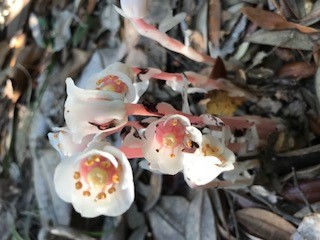
by Carrie Stevenson | Jan 25, 2018
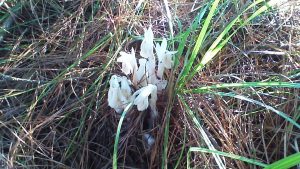
Ghost plant/Indian pipes emerging from the ground. Photo credit: Carol Lord, UF IFAS Extension
Imagine you are enjoying perfect fall weather on a hike with your family, when suddenly you come upon a ghost. Translucent white, small and creeping out of the ground behind a tree, you stop and look closer to figure out what it is you’ve just seen. In such an environment, the “ghost” you might come across is the perennial wildflower known as the ghost plant (Monotropa uniflora, also known as Indian pipe). Maybe it’s not the same spirit from the creepy story during last night’s campfire, but it’s quite unexpected, nonetheless. The plant is an unusual shade of white because it does not photosynthesize like most plants, and therefore does not create cholorophyll needed for green leaves.
In deeply shaded forests, a thick layer of fallen leaves, dead branches, and even decaying animals forms a thick mulch around tree bases. This humus layer is warm and holds moisture, creating the perfect environment for mushrooms and other fungi to grow. Because there is very little sunlight filtering down to the forest floor, the ghost flower plant adapted to this shady, wet environment by parasitizing the fungi growing in the woods. Ghost plants and their close relatives are known as mycotrophs (myco: fungus, troph: feeding).
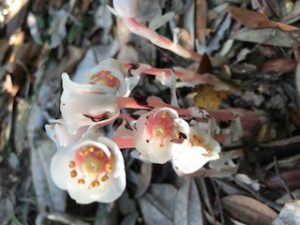
Ghost plant in bloom at Naval Live Oaks reservation in Gulf Breeze, Florida. Photo credit: Shelley W. Johnson
These plants were once called saprophytes (sapro: rotten, phyte: plant), with the assumption that they fed directly on decaying matter in the same way as fungi. They even look like mushrooms when emerging from the soil. However, research has shown the relationship is much more complex. While many trees have symbiotic relationships with fungi living among their root systems, the mycotrophs actually capitalize on that relationship, tapping into in the flow of carbon between trees and fungi and taking their nutrients.
Mycotrophs grow throughout the United States except in the southwest and Rockies, although they are a somewhat rare find. The ghost plant is mostly a translucent shade of white, but has some pale pink and black spots. The flower points down when it emerges (looking like its “pipe” nickname) but opens up and releases seed as it matures. They are usually found in a cluster of several blooms.
The next time you explore the forests around you, look down—you just might see a ghost!
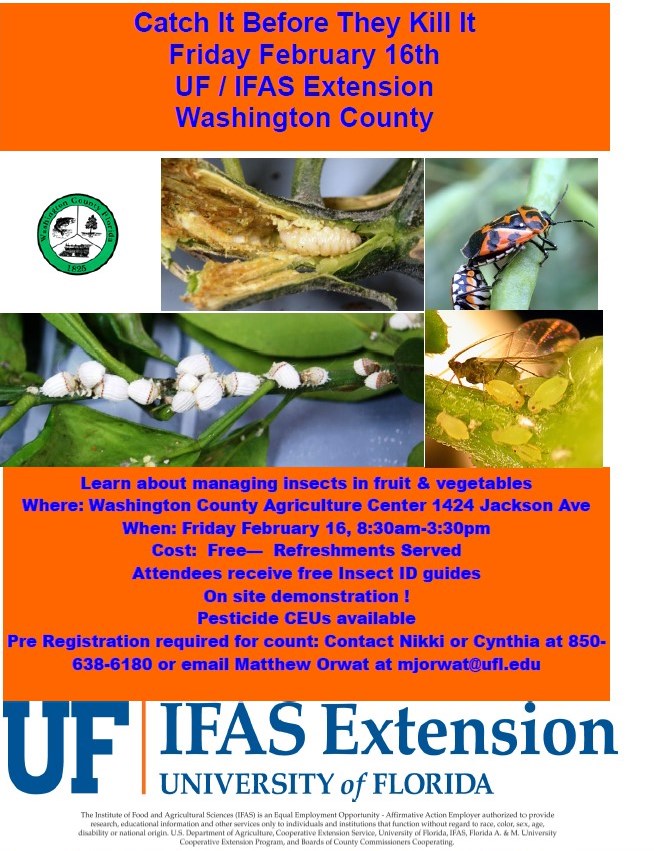
by Matthew Orwat | Jan 23, 2018
Please join us for an informative workshop to learn about managing insects in fruit & vegetables. You will learn how to identify common insect pests, control insect pests and submit samples for diagnosis from University of Florida / IFAS specialists. Attendees will receive free Insect ID guides and participate in an on-site demonstration ! Pesticide CEUs will be available for license holders as well. This workshop Washington County Agriculture Center 1424 Jackson Ave., East wing. it will be Friday February 16, 8:30am-3:30pm and there is no cost. Pre-Registration required for count: Contact Nikki or Cynthia at 850-638-6180 or email Matthew Orwat at mjorwat@ufl.edu

Agenda
Welcome 8:30am-8:35am
Matthew Orwat, Washington County Cooperative Extension
Introduction 8:35am-8:40am
Amanda Hodges, University of Florida
True bugs in Spring Vegetables-Identification and Management 9:00am-10:15am
Amanda Hodges and Ploy Kurdmongkoltham, University of Florida
Cowpea Curculio 10:15am-10:30pm
Ploy Kurdmongkoltham and Amanda Hodges, University of Florida
Break 10:30am-10:45am
Whitefly Management 10:45am-11:10am
Matthew Orwat, Washington County Extension
Importance of Invasive Species to North Florida Vegetable Production 11:10am-11:30am
Amanda Hodges, University of Florida
Invasive Stink Bugs and Related True Bugs 11:30am-11:50pm
Brown Marmorated Stink Bug, Bagrada Bug, and Kudzu Bug
Amanda Hodges, University of Florida
Lunch 11:50pm-12:30pm
Tomato leafminer Tuta absoltua 12:30m-12:45pm
Brad Danner, FDACS-DPI Survey Specialist
Old World bollworm and Exotic Spodoptera Pests 12:45pm-1:05pm
Silvana Paula-Moraes, University of Florida
Common Vegetable Plant Diseases in the Florida Panhandle
curcubits and hands on samples 1:05pm-1:35pm
Sanju Kunwar, University of Florida
Pest and Pathogen Walk 1:35pm-2:05pm
CAPS Exotic Corn Diseases of Concern 2:05pm-2:35pm
Brad Danner, FDACS-DPI Survey Specialist
Sample Submission, Arthropod and Disease samples 2:35pm-2:50pm
Ploy Kurdmongkoltham and Amanda Hodges, University of Florida
Conclusion and Post-Workshop Survey 2:50pm-3:15pm
Amanda Hodges, University of Florida









